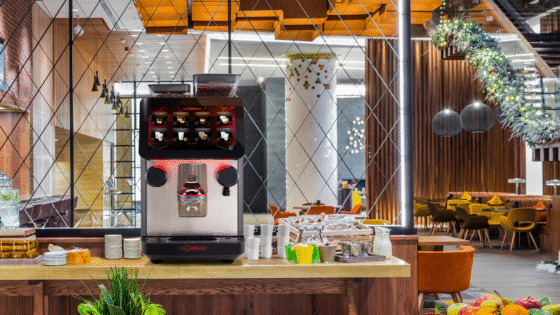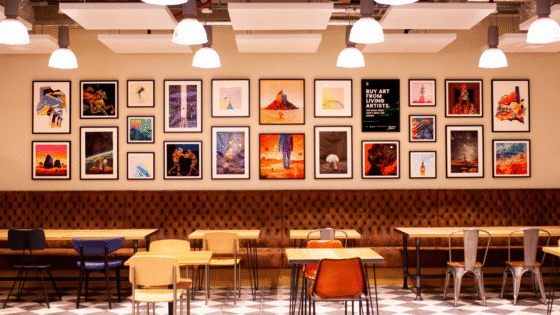Travelling 7,500 miles to Zimbabwe, editor of Hotel Designs Hamish Kilburn learns more about the design direction of one of the country’s most luxurious hotel offerings, the award-winning Matetsi Victoria Falls…
Beyond the baobab trees – which are said to be sacred among the locals because of the natural healing powers they lock within their roots.
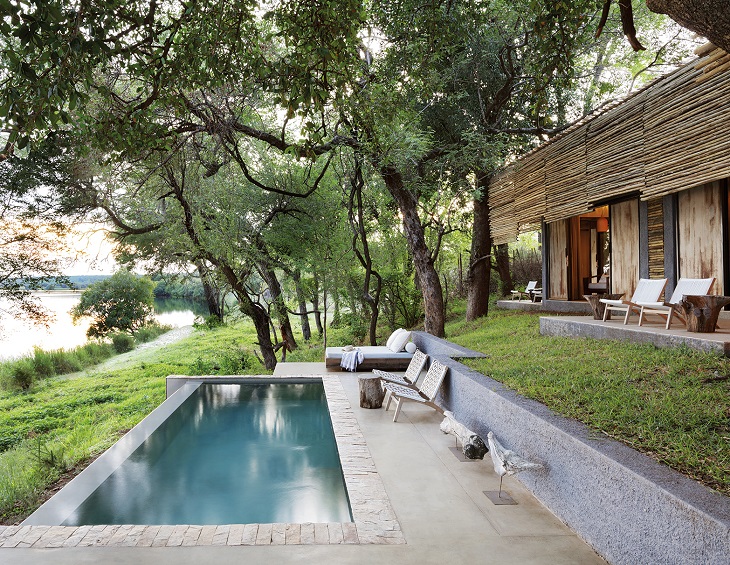
In betweek the dehydrated shrubs on the African soil, elephants, hyenas, zebras, warthogs, leapards and lions sits an award-winning luxury riverside hotel that is indubitably one of the most luxurious offerings in Zimbabwe.
After 15 minutes 4x4ing the dirt road into the heart of the 123,000-acre (55,000 hectres) reserve, we arrive at Matetsi Victoria Falls, a place that promises luxury, comfort and unmatched style. “I have the largest back yard in Africa,” jokes the owner John Gardiner who greets me on arrival. And with nothing between us and the natural safari, my experience in the African bush begins.
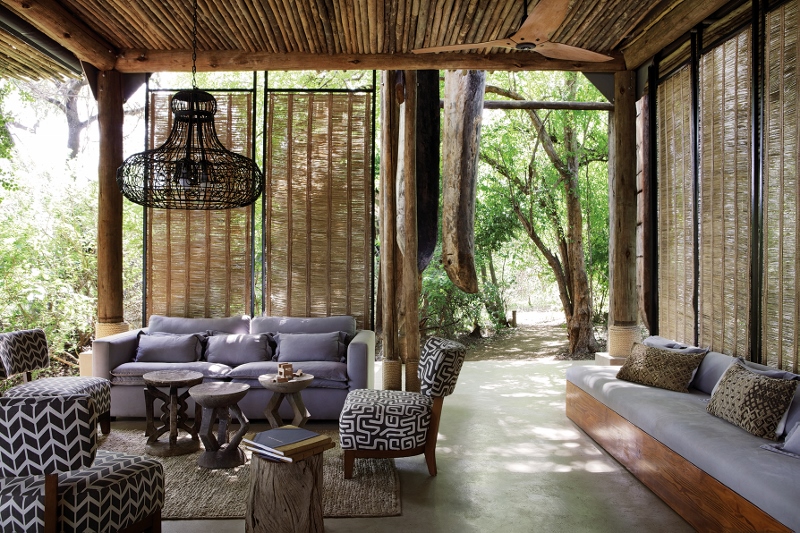
The entrance of the hotel is framed by three traditional Mokoro (dug-out) canoes, which hang from wooden beams and sway in harmony with the soft Zambezi breeze. With no need for a traditional lobby, guests are immediately welcomed into the indoor-outdoor public areas complete with a copper bar and durable outdoor sofas and chairs scattered in a home-from-home setting that has been designed around nature, and not the other way round. “We didn’t take out a single tree when designing these camps, because we wanted these areas to remain as close to nature as we could,” said interior designer Kerry van Leenhoff , a previous graduate from Cape Town University of Technology who was hand-selected by Gardiner and totally supported in all her decisions. Using the striking vista of the Zambezi River, which flows towards the tremendous Victoria Falls, dining tables are placed in such a way to make every meal one to remember. “The lobby areas have been designed in order to encourage guests to connect with people and nature,” adds van Leenhoff.
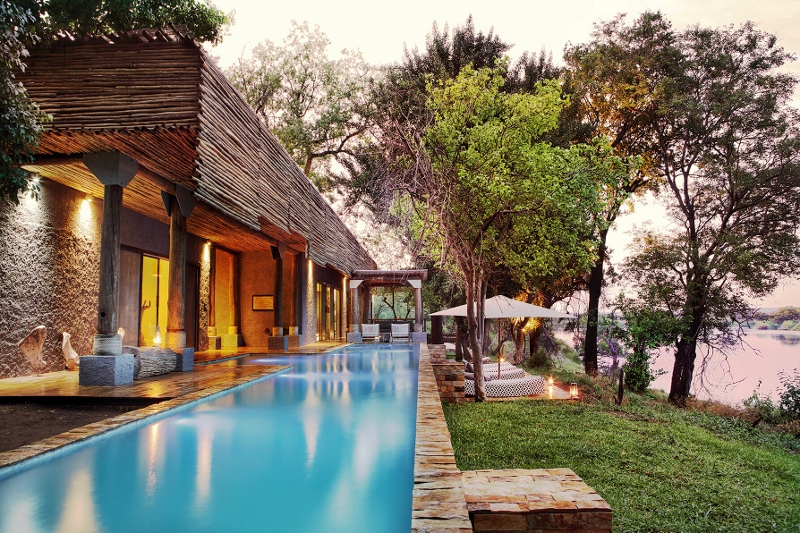
As we approach suite 17 – AKA, my home for the next four nights – I am reminded just how ‘in the sticks’ we are, catching a glimpse of an elephant and a giraffe just metres from each other as my key enters the lock. I open the heavy, black teak front door, which was recycled and polished from the previous lodge, and the room is immediately filled with light. Interestingly enough, though, this was not the case when the hotel first opened, as van Leenhoff explains: “When the hotel first opened and the guests gave us their feedback, we realised that we needed to revisit the lighting, especially in the public areas,” she says. “So we added some more outdoor feature lighting around the trees and columns in order to really pronounce what we felt were the important and dramatic areas of the hotel.” However, my immediate attention is not on the lighting. Instead, my imagination is taken over by the striking panoramic view of the Zambezi River, which I later find out is home to legend; the locals believe that a famous God is said to protect the flowing waters, and his name is Nyami Nyami. As legend goes, the spirit which is often depicted as half snake half fish, protects life in and around the river.
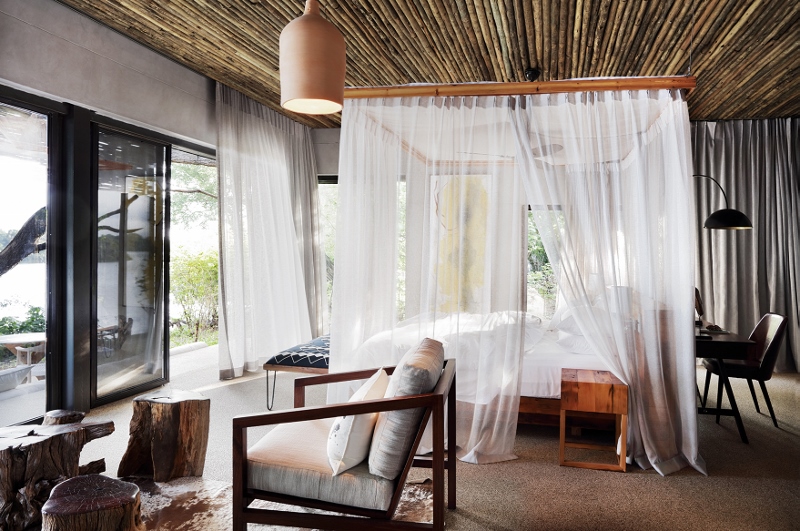
The River Lodge Suite is everything you would expect of a luxury lodge in the bush, and so much more. The skin of matepi latte creates an organic ceiling and roof – and this material does more than just give a nod to the location. This decision was made in order to keep the lodge blending into its location and celebrate Zimbabwean culture. “It was really important for us to work with skilled craftsmen and women from our culture,” explains van Leenhoff. “We have such a diverse culture with about 16 different tribes and languages. We mainly focused around the Tonga tribes as we were by the river.” The result is that from the far side of the river, you can’t actually see where the hotel starts and ends, which suggests even further that the whole property has been created with nature in mind.
Van Leenhoff decided to take Matetsi’s love for nature and the environment and inject it into the fabrics and the walls. The result is a naturally calming, peaceful abode, which empowers an everlasting feeling of total luxury and relaxation. Modern high-quality furniture and hand-scultpted trunks of trees used as tables create the perfect blend of modern, luxury and timeless décor.
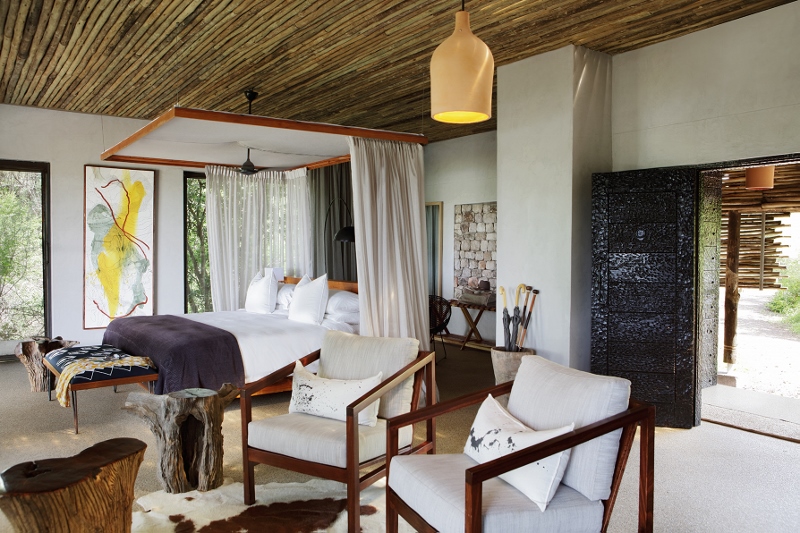
All 18 suites have been thoughtfully curated and the hotel is a credit to the talent of van Leenhoff. The art, for example is by Helen Teede who spent much time on site at Matetsi in order to find the inspiration of a unique collection of 18 paintings entitled ‘Mapping Matetsi’. Having done extensive walks and drives in the area, Teede divided the cartographic map of Matetsi unit seven into 18 parts and drew it to scale on each canvas, adding her own impressions of the river, the landscape and the pathways walked in the area, both man and animal-made. These 18 paintings hang separately in each suite. However, put together and these pieces of art actually form the aerial map of the reserve.
With the privilege of space, the hotel shelters two camps: East Camp, West Camp and one large villa, River House, which sits in between the two camps. Interestingly, the whole team – chefs, butlers, housekeeping, back-of-house staff – alternate between both East and West camp every couple of weeks in order to maintain the property and keep service personable at all times.
[easingslider id=”36178″]
Gardiner, who I first met in London just a few weeks before my trip, is the real visionary behind the property surrounding the reserve. A local Zimbabwean hotelier, Gardiner has transformed the reserve since acquiring it in 2014 and aims to “give back to Zimbabwe”. With the help of his team, who all share Gardiner’s love for nature, he has restored and conserved the natural wildlife within the reserve by building various watering holes, 15 in total with a further 10 in the pipeline, I am told.
Before I check out, I have an opportunity to exclusively discuss the future of Matetsi with the team and how it plans to expand its luxury arm. “We are working on a few things at the moment, which are really exciting projects,” adds van Leenhoff. “The design direction and our aim is to strike the balance between feeling isolated and feeling safe.” The new plans will further challenge conventional luxury lodges in Africa with a real focus on opening up the guests to undisturbed nature.
The future sounds exciting and it’s clear that the design team and the hotel are totally in sync with ideas, vision and what luxury in Africa should look like. I leave Matetsi and Zimbabwe having cemented my respect in African design and culture. I am grateful that the reserve’s calming atmosphere allowed me to relax and escape from the lively London scene, if not only for a few days.
Key suppliers
Guest Suites-
Tables/ Headboards/ Beds- Adam Seager Furniture (ZIM)
Upholstery – Fiona Edmunds (ZIM)
Desks/ Luggage racks/ Wardrobes/ Lounge chairs – Nigel Joselyn (ZIM)
Pottery Pendants and Chandeliers- Chart Pottery (ZIM)
Beaded Ottomans- CHIPO women’s group (ZIM)
Spring stone Basins- Tonderayi Mahachi (ZIM)
Bamboo Lights- STEP Trust (ZIM)
Floor lamps- Collaboration between Bruce Elliot & Tonderayi Mahachi (ZIM)
Porcupine wastepaper baskets- Lupane Women’s Centre (ZIM)
Basin Tops- Zambezi Roots (ZIM)
Bath- Euro trends (SA)
Sanitary ware- Antique baths (SA)
Nguni Cowhides- Holly Hudson (ZIM)
Ceramics- Marjorie Wallace: Mutapo (ZIM)
Mirrors- Brigette Lotter (ZIM)
Main areas-
Dining tables- Adam Seager Furniture (ZIM)
Woven Screens- Collaboration between Jane Taylor & Judith Ncube of Matabeleland Weavers (ZIM)
Curated Tables- Helen Teede (ZIM)
Bar and Interactive kitchen- Collaboration between Adam Seager & Copperwares (ZIM)
Woven Poufs – Lupane Women’s Centre (ZIM)
Wrought Iron lights- Misty Edwards (ZIM)
Pottery Pendants and Chandeliers- Chart Pottery (ZIM)
Reed mats- Newlands Craft Market (ZIM)
Shop – Nigel Joselyn (ZIM)
Sofas- Fiona Edmunds (ZIM)
Coco chairs- Coricraft (SA)
Chairs/ Bar stools- Weylandts (SA)
Boardroom table- Collaboration between Zambezi Roots & Complete Steel (ZIM)
Ceramics- Marjorie Wallace: Mutapo (ZIM)
Wine cellar Chandeliers- Basil & Lindy Rowlands (ZIM)
Wine cellar- Ruwa Furniture (ZIM)

